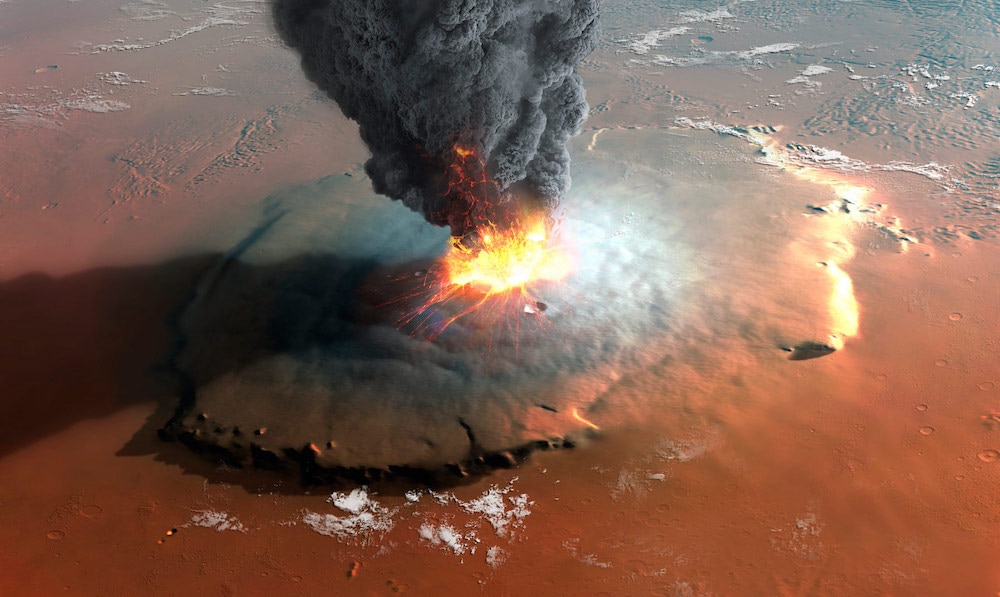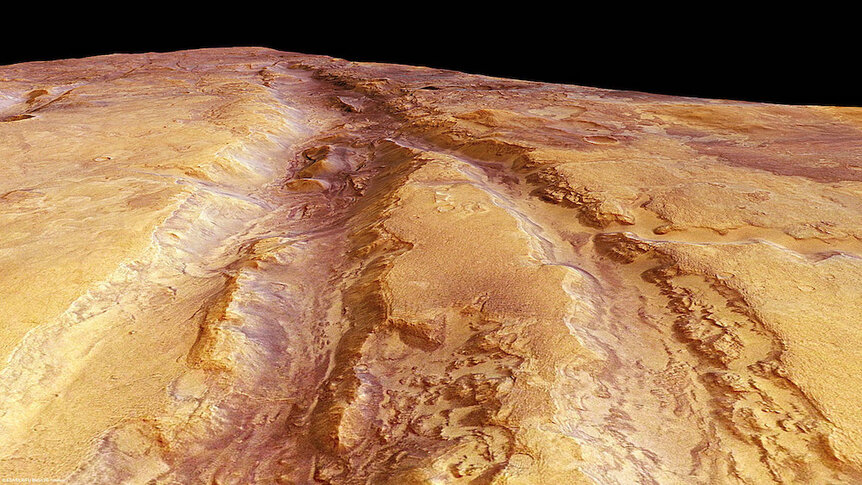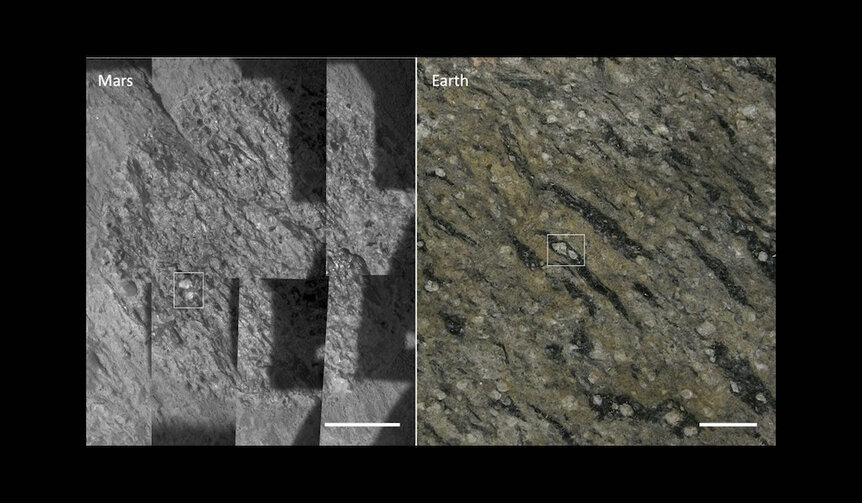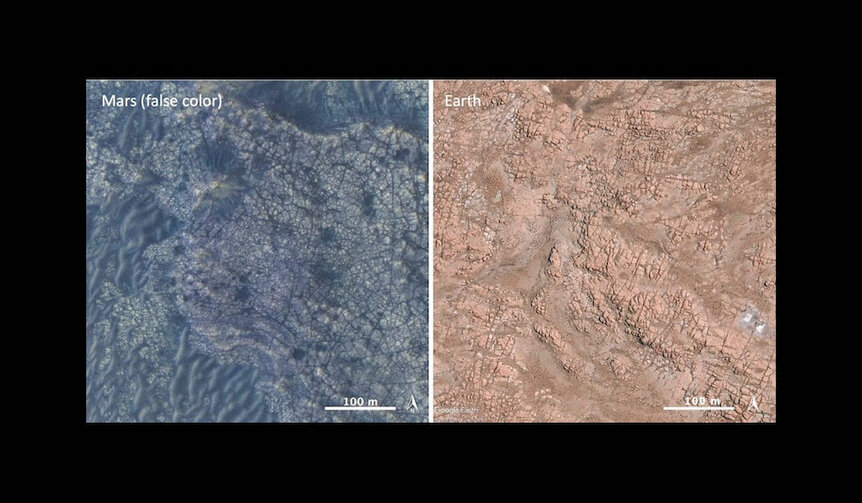Create a free profile to get unlimited access to exclusive videos, sweepstakes, and more!
The history of Mars may have been more explosively volcanic than we thought
Martian rocks shows signs of violent volcanism.

In the deep past, Mars was wildly volcanic.
In some ways this is obvious. The Tharsis region, somewhat smaller than the continental U.S., boasts 12 large volcanoes, including Olympus Mons, the largest volcano known in the entire solar system. It’s 22 km high and 600 km wide, as wide as Colorado.
Also, the surface of the planet is covered in basalt, a dark gray volcanic rock. It’s everywhere, indicating most of the surface rocks were emplaced by volcanoes. Later, that was modified by air, water — almost all gone now, but back in the day 3 or 4 billion years ago Mars was fairly wet — and asteroid/comet impacts.
But there are different kinds of volcanic eruptions. Some are explosive and catastrophic, but others are slow and less violent. They produce different kinds of rocks, and that can tell you a lot about the history of an area.
Nili Fossae is a region on Mars characterized by long concentric troughs in the ground called graben. They may be stress-induced cracks from nearby impacts, or from swelling of the surface from underground activity. It’s unusual for Mars in that it’s very rich in the mineral olivine, which on Earth forms in the mantle.
Presumably on Mars it did as well. It can be erupted out by volcanoes or dug up by big impacts and distributed around. It’s also rich in carbonates, another mineral found in volcanic eruptions.
Jezero crater is in Nili Fossae, which is convenient: That’s where the Perseverance rover is currently tooling around. That means that mineral assays done from orbit can be compared to literal ground truth.
And this is where the fun begins: Another crater has also been found to be abnormally rich in olivines and carbonates: Gusev crater, which is where the Spirit rover explored from 2004 to 2010. Nili Fossae and Gusev are the two olivine-richest regions on Mars.
What’s odd is that they’re 6,000 kilometers apart! It’s unlikely that they have the same source of olivines and carbonates, so this implies that whatever made them that way must have happened in at least two places on Mars, which in turn implies it was an important process in Martian geology.
So were these minerals gently laid out on the surface of Mars in these two regions, or was the deposition more violent?
When it comes to Nili Fossae in particular there’s been a lot of debate about that. But new work strongly suggests that it was the latter: Whatever enriched these two wildly separated areas was very violent. And not just that, but repeatedly violent.
A team of scientists looked at images from Jezero and Gusev provided by the rovers using their close-up cameras, getting magnified views of the structures of the rocks [link to paper]. Curious dark streaks were seen in Gusev rocks, shaped something like flames. This kind of structure is called fiamme (Italian for “flame”) and is indicative of pumice rocks that have been crushed under pressure and heated. This is also seen on Earth.
That’s interesting! That type of thing happens during violent volcanic eruptions called pyroclastic flows, where gas and superheated ash blast out of a volcanic vent and scream downhill at speeds of hundreds of kilometers per hour. This material gets laid down over and again in layers during episodic energetic eruptions, so you wind up with a bizarre mix of igneous and sedimentary rocks: They’re volcanic, so igneous, but layered, so sedimentary. The weight of the layers above plus the heat can weld and deform the pumice to make fiamme.
This type of rock in general is called ignimbrite — from the Latin for fire (igni) and rain (imbri), so a rain of fiery debris. That would imply the deposits at Nili Fossae and Gusev were indeed created in terrifying events.
There’s more. At Nili Fossae, orbital images show long roughly parallel cracks in the rocky surface that geologists call joints. That’s common in cooling ignimbrite, which contracts as it cools and generates a series of joints. This also jumped out at the scientists, who noted that the same thing is seen on Earth, again in welded ignimbrite deposits, again strongly implying that these rocks were not made gently.
They also make other, more subtle arguments, but in the end all their evidence points at titanic, repeated violent eruptions. I’ll note the evidence supports that, but it’s circumstantial. There might be other ways to make these structures on Mars that we don’t know about yet. But still, if I were to bet, this looks like good odds.
No doubt we’ll learn more as more missions are sent to the Red Planet. The history of Mars is, much like Earth, a study in long, slow processes punctuated by sudden, scary ones. Volcanism played an outsized role, so just knowing what kind of volcanism it was is a good step forward.
And we still don’t know what happened to its air and its water. A lot of Mars has been mapped, and in detail, and we’re even learning about its interior. But it’s a big planet. Smaller than Earth, but it’s a long way away and difficult to study. Scientists are getting better at it all the time, and this flood of data from the past few years will take decades to sort out. This argument isn’t over yet, and even when it is it will have to fit into the bigger picture of Mars. There’s a lot more to figure out.





























